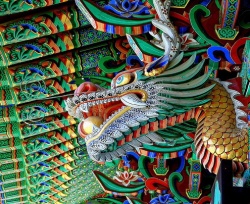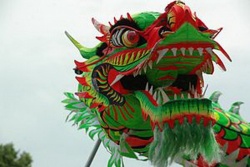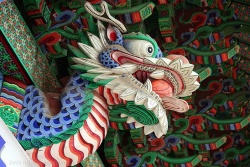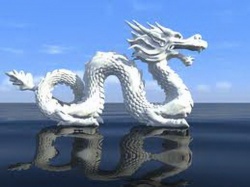Dragon of the Mekong
When I visited Ubon Ratchatani, I stayed at Wat Kitivaro, a huge enclosed forest monastery; a shabby, unkempt, run down monastery. A pack of 20 half-feral dogs ran free-reign throughout the grounds, on friendly terms with the local monks, but aggressive towards visitors like me. I was on my constant guard against being attacked by the dogs when no local monk was present to fend them off.
Huge coconut trees, nearly fifty-feet tall, reach into the blue tropical skies above the monks’ wooden huts.
Venerable Siripunno, an old monk who was a student of the famous teacher Ajahn Fan, lived in a small hut near the back of the wooded temple compound. He had been a monk for 42 years, ordained in 1967.
Delighted to have a chance to practice his English skills, he came to talk to me several evenings during my stay in the monastery. He had learned to speak English when he was a boy, through his interactions with the American GIs stationed in Ubon Air Base, where he worked small jobs. He still feels affection for Americans, and nostalgia for his boyhood memories.
I asked him if the local people actually believe in the Naga, the Mekong River dragon. “The Mekong River is a Nine Headed Dragon,” Venerable Siripunno said. “The people do believe in the Mekong River naga. It has scales like a fish, rather than skin like a snake or eel.”
“The naga is crowned or horned,” he said. “It moves through the later like an eel.”
He demonstrated for me, in hand motions, how nagas move through the water.
How to understand this assertion of dragons as real; as a matter of fact?
I recalled Karl Jung’s statement that there are many things in this world that we don’t understand: “Rationalism and doctrinarism are the disease of our time. They pretend to have all the answers. But a great deal will yet be discovered which our present limited view would have ruled out as impossible. Our concept of space and time have only approximate validity.”
In the year 2000, the journalist Richard Freeman led an expedition to Thailand in search of the mythical Mekong River Dragon – the naga. The expedition was commissioned by Discovery Channel.
“The Naga is essentially a gigantic snake, usually found in Hindu and Buddhist mythology,” Freeman said. “It is supposed to bear an erectile crest on its head rather like that of a cockatoo, but made of scales, which it holds menacingly aloft when angry, just as a cobra opens its hood.”
“Legend says the nagas possess immense intelligence and magical powers. They can, for instance, transform themselves into humans and walk unnoticed in the world of men. It is believed they inhabit grand underwater palaces, rather like the dragons of China…the naga is not satisfied with being a legend and still rears its scaly head, being sighted up and down the Mekong River even today.”
Freeman interviewed a 70 year old man named Pimpa, who claimed to have had a personal, terrifying encountered a naga. Pimpa lived in “an extremely remote village in the forested hills”, where he came face-to-face with a dragon while exploring some underground caves, connected to the Mekong.
Freeman followed Mr. Pimpa into the caves into the naga’s lair, for about a mile into the narrow, dank, labyrinth of tunnels.
“The old man had been exploring by candlelight when he turned into the cave and came across a giant snake. Its head was in the shadows, but the visible portion of its body was 60-ft long. Mr. Pimpa had pressed himself against the wall in terror as the giant reptile crawled past at an astoundingly slow pace. Its scales were black with glossy green sheen, and it was around 2.5 to 3-feet thick. Finally, it had disappeared along the passage, and Mr. Pimpa had collapsed gasping in relief.”
Freeman tried to give a rational explanation to the persistent, unshakable belief in the existence of the naga among the people who live along the Mekong River. “There was once a group of primarily aquatic snakes which reached immense sizes. The Madtsoids…were found worldwide…Reports from all over the tropics suggest that some species may have survived to the present day. As well as their great size, all these monster snakes seem to share strange ornamentation on their head. The manotauro or sucuriju gigante of the Amazon is believed to have horns, and Indochina’s naga has a crest. Horns are not unknown on snakes; the rhinoceros viper of Africa and the horned viper of the Middle East are just two examples. Although their horns are actually modified snakes.”
The Mekong River forests of Burma, China, Laos, Cambodia and Thailand is one of the most vast and unique regions of the earth, bounding in life, surpassing the richness and diversity of the Amazon Rain forest.
In early 2009, the World Wildlife Fund released studies that identified thousands of new species previously unknown, including spectacular insects, reptiles, amphibians, and mammals. Perhaps they’ll find a naga.
Personally, I’ll suspend judgment. There are things in this world that we don’t understand.
“You must go visit my home place in Nakon Phanom,” Venerable Siripunno told me. “You must visit vipassana center Wat Sitep. It is the best place, the best teacher – Chao Khun Tep, long time ago.”
He described the beauty of his homeland to me, the forest and scenery of flora and fauna along the Mekong River. A look of longing and joy came over his face as he remembered the distant scenes of the beautiful mountain-scapes of Laos, across the Mekong River, standing against the eastern horizon.
“The Mekong River is a nine-headed dragon,” Venerable Siripunno said.
The Mekong River is the realm of Sisattanag (Seven Headed Dragon). The That Phanom Chronicle says the Mekong River was dug by the naga -- literally River-dug-by-the-chest-of-a-naga -- when Indra cast him from Nong Sae, somewhere in southern China.
Many naga serpent-dragons followed, came to live in his realm, Suvannaphumi – the Land of Gold.
The Mekong is not a border, but is rather a central artery to the forest tradition of Theravada Buddhism.
When you see the Mekong, you feel the presence of the naga and spirits. You know for sure you’re in paradise. Bewitched, led by the spirit of the Mekong, by a mystery of the beauty of the place, you sense the real presence of the spirits, and realize the actual magic.
Such a beautiful world, so strongly seductive that one simply cannot leave it without sadness. There is something about the Mekong which, even years later, makes you want to sit down beside it and watch our whole life go by, writers waxed poetic under its spell.
The Mekong River is alive. It is the Dharma River. You will be actually enchanted, and commune with the spirit of the Mekong. It is a presence and mystery, and it will flow through you, as it spreads out into ‘nine heads’ of the Mekong Delta, and empty in the jade-green waters of the South China Sea.
The naga is protector of the Buddha.



